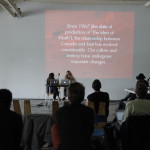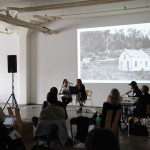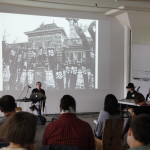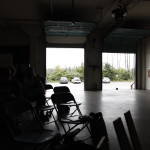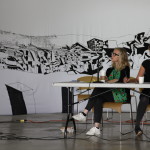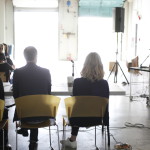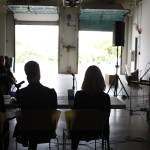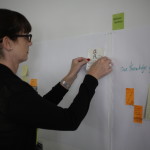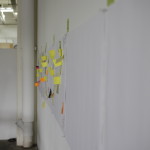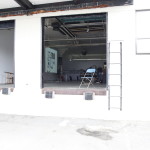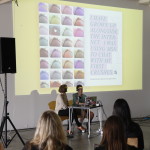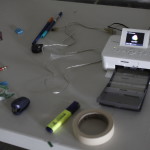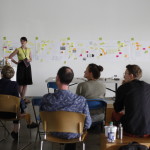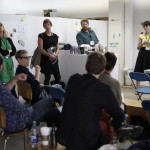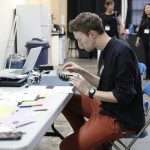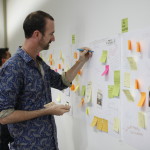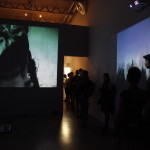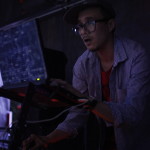

Terminus: Archives, Ephemera and Electronic Art was a workshop organized by the Ethnographic Terminalia Collective in collaboration with Tarah Hogue and Glenn Alteen of the grunt gallery in Vancouver B.C. The workshop took place as a part of the 2015 International Symposium on Electronic Art (ISEA) and was held at VIVO Media Arts Centre in Vancouver on August 18th, 2015. It featured presentations from international and local media artists and resulted in a collaboratively-produced zine-inspired catalogue of the day’s events and conversations. The zine was printed in limited numbers and distributed during ISEA and at the grunt gallery. It can be viewed in digital form here on this website, and audio recordings of the presentations are available here.
The Workshop was an extension of the grunt gallery’s concurrent exhibition ARCTICNOISE by Geronimo Inutiq, curated by Britt Gallpen and Yasmin Nurming-Por, co-organized by Tarah Hogue and the Ethnographic Terminalia Collective. You can view documentation of the event and watch a video interview with curator Tarah Hogue here.
Following the workshop and the opening of ARCTICNOISE on August 20th, 2015, a public symposium titled ARCTICNOISE: Dialogues was held at the Native Education College. It included presentations by artist Geronimo Inutiq, curators Britt Gallpen and Yasmin Nurming-Por, Glen Alteen (Director, grunt gallery), Christine Lalonde (National Gallery of Canada), and Raymond Boisjoly (Emily Carr University). You can view images of the event and presentations here.
About the publication “Terminus: Archives, Ephemera and Electronic Art”
For “Terminus: Archives, Ephemera, and Electronic Art”, we put out a call for workshop participants to demonstrate and discuss electronic art works and theoretical frameworks that disrupt material, figurative, discursive, cultural, and political manifestations of the archive, broadly conceived. However, given the workshop format, and our interest in experimenting with alternative forms of scholarly communication, we wondered if we could also transform what could have been a standard set of conference proceedings into a creative critique of the ‘archival’ paper. The proposals were reviewed and selected by the Ethnographic Terminalia collective in collaboration with Tarah Hogue and Karlene Harvey of the grunt gallery.
In the workshop preparation stage, we invited workshop presenters to provide us with a four-page representation of their presentation, without any suggestion for style or content. Inspired by Garnet Hertz’s Critical Making project (2012), each of these contributions is presented, as it was sent, in the order of the presentations made during the workshop. In addition, however, during the workshop itself, participants and observers were all asked to document their questions, comments, doodles, tweets, and other responses, and to contribute them to a group-constructed analogue collage of responses to the day’s presentations. We were inspired by Michael Taussig’s discussions of his field sketches (2011), and by George Marcus’s explorations of dynamic anthropological archives, studios, labs, and parasites, and the dialogic modes for ethnographic research that they may present (2012). Here our goal was to playfully explore possibilities for breaking the sterile seal of the archival paper––its strict formatting conventions, its restrictions on visual content, for example––and impose a representation of the ephemera of scholarly and creative gatherings on the document itself.
We wanted to coerce an acknowledgement that the anarchival elements of knowledge-exchange events like this one often comprise the most significant outcomes of scholarly and artistic work. We had hoped that participants would find a way to include the marginalia that emerges in the throes of attention, for questions that arise for the presenter, for gestures that signal the moment of chance that emerges from conversation. Over the course of the one-day event, participants collaged their drawings, notes, polaroids, and other contributions onto posters for each presentation that were taped to the wall at the back of the room. At the end of the day, we photographed all of these posters, and imported them into the skeleton catalogue document that we had prepared in advance. We added photographs from the event, our introductory essay and acknowledgements, and printed the zine the next day. We handed out copies to workshop participants and to the public at the opening of ARCTICNOISE at the grunt gallery on August 20th, 2015.
In this publication, we hope that the reader is able to witness how our transitory moments of engagement with instances of archives and electronic art were recorded, prioritizing the ephemeral and the visual over the textual conference proceeding. We hope that the reader is able to glean the exciting nuances that emerged in the process of making and modifying this publication together, a veritable archive of the anarchival.
Terminus Presentations
Since 2009, the Ethnographic Terminalia Curatorial Collective has staged annual exhibitions in major North American cities (Washington D.C., Chicago, New York, San Francisco, Montreal, New Orleans, Philadelphia) that explore the intersections of art and anthropology. Archives, ephemera, and Indigenous articulations of new media, identity, culture, language, and resistance have emerged as central themes in contemporary art-ethnographic practice and as a central interest to the curatorial work of the collective. New technologies, both materially and conceptually, present opportunities to push theoretical, disciplinary, and aesthetic boundaries. However, the implications of digitization and circulation of archival information present particularly interesting challenges for artists and scholars who seek to represent and exploit the potential of digital archives. Building on the collective’s recent exhibitions, and in conjunction with an exhibition of new media artist Geronimo Inutiq’s ARCTICNOISE project, co-curated for ISEA 2015 at the grunt gallery in Vancouver (Terminal City), Ethnographic Terminalia invited workshop participants to demonstrate and discuss electronic art works and theoretical frameworks that disrupt material, figurative, discursive, cultural, and political manifestations of the archive, broadly conceived. These discussions of new technologies and archives culminated in an experimentation with form: the outcome of the workshop is a collectively hand-made archive/catalogue of the event that is now available for online circulation.
Workshop presentations were made by Britt Gallpen, Yasmin Nurming-Por, Rosemary Georgeson, Jessica Hallenbeck, Beverly Curran, Grayson Cooke, Gustavo Valdivia, Gabriela Aceves Sepúlveda, Jacek Smolicki, and In the Bush Collective. Discussants were Tarah Hogue, Trudi Lynn Smith, and Stephanie Takaragawa. The event was moderated by Kate Hennessy, with additional facilitation by Craig Campbell and Fiona P. McDonald.
The workshop was conceptualized and organized by the Ethnographic Terminalia Collective: Kate Hennessy, Trudi Lynn Smith, Craig Campbell, Fiona P. McDonald, Stephanie Takaragawa; with Glenn Alteen and Tarah Hogue (grunt gallery)
ARCTICNOISE
ARCTICNOISE is a media installation by Geronimo Inutiq (madeskimo). It was guest curated by Yasmin Nurming-Por and Britt Gallpen, and produced in conjunction with International Symposium of Electronic Arts (ISEA), Glenn Alteen and Tarah Hogue (grunt gallery), and the Ethnographic Terminalia Collective. It was exhibited at grunt gallery between August 5 -22, 2015, with an opening reception on August 17th during ISEA 2015.
ARCTICNOISE draws on archival film footage and sound materials sourced from the Isuma Archive at the National Gallery of Canada, as well as sound and film materials from the artist’s personal collection, on-site research obtained from a trip to Igloolik, and other ethnographical material. Conceived as an Indigenous response to Glenn Gould’s celebrated composition “The Idea of the North”, Inutiq appropriated Gould’s piece as a musical score, paired with new voices and imagery to produce a layered and multi-vocal work. The project folds into Inutiq’s larger practice of his alter-ego, madeskimo that draws on the use of instruments, digital and analogue synthesizers, as well as the remixing and processing of samples from a large variety of sources— including traditional Inuit, Aboriginal, modern electronic and urban music— in order to create an experimental platform.
At its crux, ARCTICNOISE intends to initiate conversations between various communities, Indigenous and non-Indigenous, and to provoke thoughtful exchange about the roles of Inuit orality and materiality in a post-colonial space within the context of new media artwork. New media, with its appropriative and collage-like nature, is employed as a specific strategy to foster a multi-vocal and multi-generational approach to these sensitive issues. The intention is to reframe archival sources alongside contemporary technologies and materials, so that insightful and affective connections will emerge. As a multimedia work, ARCTICNOISE aims to re-purpose past Inuit visual and sound media in an attempt to conflate temporalities of past and present with the aims of repurposing and mobilizing understandings of Inuit art aesthetics.
ARCTICNOISE: DIALOGUES
This public event took place on August 19th at Native Education College in Vancouver. It included an artist talk by Geronimo Inutiq, a discussion of the curatorial process by Britt Gallpen and Yasmin Nurming Por, and a presentation by Christine Lalonde, Associate Curator, Canadian Prints and Drawings, National Gallery of Canada. These presentations were followed by responses from two local participants, Raymond Boisjoly whose artistic practice engages issues of Indigeneity, language as a cultural practice, and experiential aspects of materiality; and Glenn Alteen, director of the grunt gallery.
ACKNOWLEDGEMENTS
As the product of the collective energy of a collaboration between grunt gallery and Ethnographic Terminalia, the workshop, this publication, and the related symposium and exhibition benefited from the generous expertise and assistance of many groups and individuals.
We would like to express our sincere appreciation to all of the workshop presenters for enthusiastically experimenting with the generation of content and for the collective making of this publication: Britt Gallpen, Yasmin Nurming-Por, Rosemary Georgeson, Jessica Hallenbeck, Beverly Curran, Grayson Cooke, Gustavo Valdivia, Gabriela Aceves Sepúlveda, Jacek Smolicki, and the In the Bush Collective (represented Fran Breden and Marcheline Vreen). We also thank all of the workshop observers who participated in the generation of ephemera and critical responses to the presentations, which are documented in these pages.
Our sincere thanks to all of the contributors to partner events to this workshop and publication. First, we thank Geronimo Inutiq, whose work ARCTICNOISE was exhibited at the grunt gallery in August 2015, and to all of the contributors to the event ARCTICNOISE: DIALOGUES, an artist-talk and symposium at Vancouver’s Native Education College: thank you to Geronimo Inutiq, Glenn Alteen, Britt Gallpen, Yasmin Nurming-Por, Christine Lalonde, and Raymond Boisjoly.
Thank you to Gabriela Aceves-Sepúlveda for her work in the print design preparation of the publication. For hosting our workshop, we thank Alex Muir, Elisa Ferrari, Karen Knights and Crista Dahl at VIVO Media Arts Centre. Special thanks also to Karlene Harvey, Communications Director of the grunt gallery. Thank you also to ISEA Directors Kate Armstrong, Malcolm Levy, Thecla Schiphorst, and Philippe Pasquier. Thank you to Reese Muntean, Rachel Ward, and Aynur Kadir for documenting the workshop in photography and sound.
Our grateful acknowledgement to the funders and supporters of the workshop, publication, and partner events: The Social Sciences and Humanities Research Council (SSHRC Connections Grant); the Canada Council for the Arts, Canadian Heritage, the McLean Foundation, the International Symposium for Electronic Arts (ISEA 2015), VIVO Media Arts Centre, grunt gallery, and Native Education College.
This website was produced and designed by Kate Hennessy, Kyle McIntosh (Popgun Media), Trudi Lynn Smith, and Rachel Ward.
For more information or to let us know what you think about the project, please write to ethnographicterminalia@gmail.com.
















